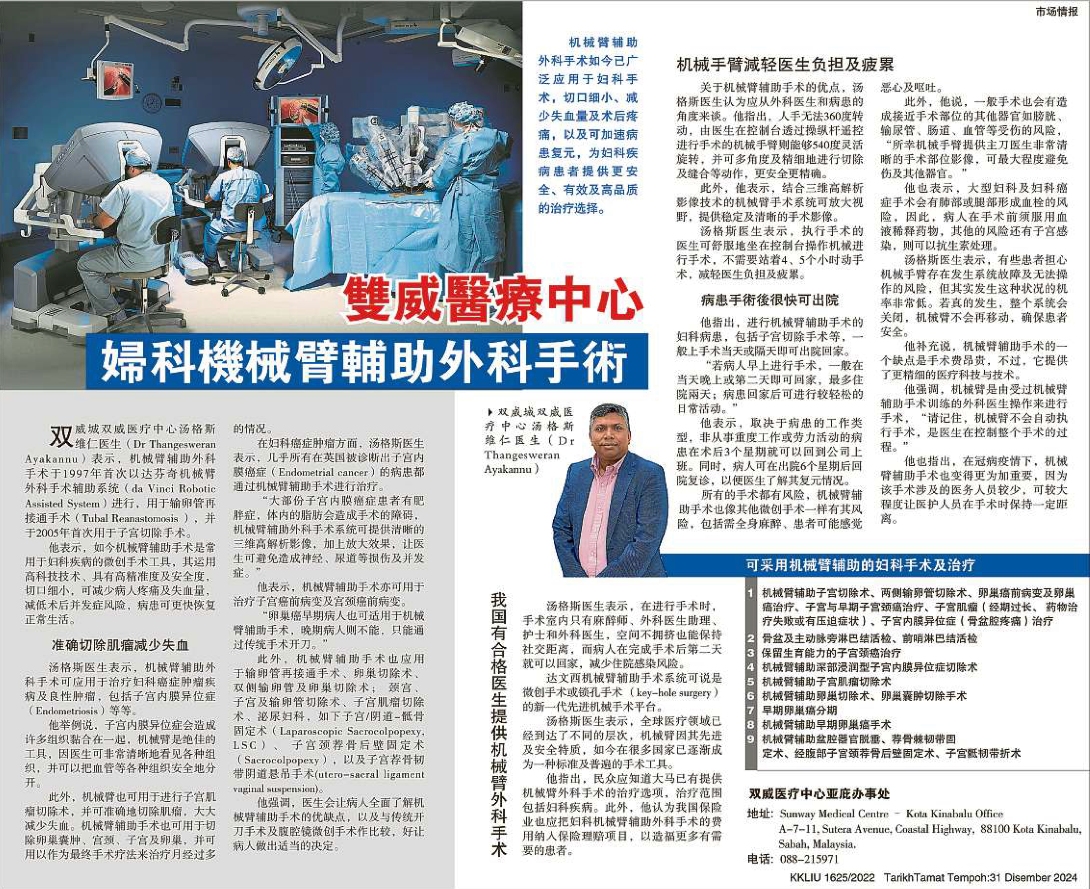Gynaecological Conditions: Advantages of Robotic Surgery
10 June 2022

Robot-assisted surgery is now widely used to treat gynaecological conditions and has become a choice treatment option for patients, providing a much safer and effective surgery with small incisions, reduced blood loss and postoperative pain, and accelerated recovery.
Dr Thangesweran Ayakannu, Consultant Gynaecologist, Gynaecology Oncology and Robotic Surgeon at Sunway Medical Centre, Sunway City said robotic surgery is used to treat gynaecological cancers and benign tumours, including endometriosis. Endometriosis causes tissues to stick together and robotic surgery is an excellent method to treat this condition as it allows the doctor to see the tissues clearly and safely separate them.
Robotic surgery can also be performed to accurately remove fibroids (myomectomy), remove cysts in the ovaries, cervix and uterus, and used as a final surgical treatment for menorrhagia. It is also used to treat uterine and cervical precancerous lesions.
“Most patients with endometrial cancer are obese, and excessive fat in the body are obstacles during surgery. Robotic surgery provides a 3D high resolution imaging with magnification effect, helping doctors to avoid injuries and complications,” Dr Thangesweran said.
Patients with early stage cancer are most suitable to undergo robotic surgery, however traditional surgery may be more suited for patients with advanced cancer. Dr Thangesweran emphasised that there should be a discussion between the doctor and patient to fully understand the advantages and disadvantages of robotic surgery compared to open surgery and laparoscopic surgery so that the patient can make a sound decision.
He highlighted the fact that the human hand cannot rotate 360 degrees while the robotic-arm that is remotely operated by the doctor can flexibly rotate 540 degrees to perform excision and suturing at multiple angles, making accurate cuts and stitches. Combine that with 3D high resolution imaging, the field of view is enlarged providing clear surgical images.
Also, the surgeon can sit comfortably at the control panel to perform the operation. This reduces the burden and fatigue on the doctor as it eliminates the need for the surgeon to stand for 4 to 5 hours when performing a surgery.
Patients who undergo robotic surgery are discharged on the same day or the next day. “If the patient had surgery in the morning, they can usually go home in the evening, the next day or stay up to two days. Depending on the type of work the patients do, those who are not engaged in heavy physical activity can return to work 3 days after surgery and return to hospital for a follow-up after 6 weeks,” Dr Thangesweran said.
Surgery on gynaecological cancers carry the risk of blood clots in the lungs or legs, so patients must take blood thinning drugs before surgery. Other risks like uterine infection can be treated with antibiotics. All surgeries have risk, even robotic surgery has its risks from general anaesthetic and patients may experience nausea and vomiting.
For those who are concerned that robotic surgery has a risk of system failure, the chances of it happening is very low and if it does happen, the entire system will shut down and the robotic arm will not move, stressed Dr Thangesweran. “Remember, the robotic arm is operated by surgeons trained in robotic surgery. The robotic arm does not perform the surgery on its own; it is the doctor who controls the entire surgical process.”
Robotic surgery with the da Vinci Surgical system may be expensive but it is a more sophisticated medical technology with elegant techniques. The global medical field has reached different levels and robot-assisted surgeries are now a standard and a common tool due to its advanced safety features.
Source: Sin Chew Sabah
Back


